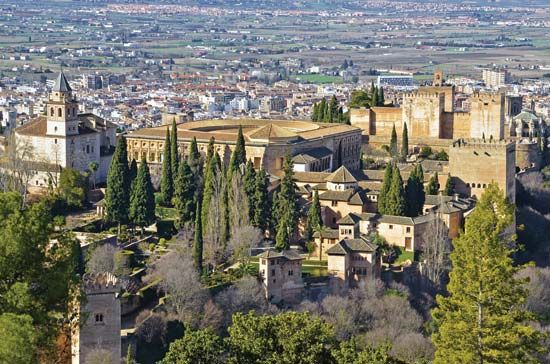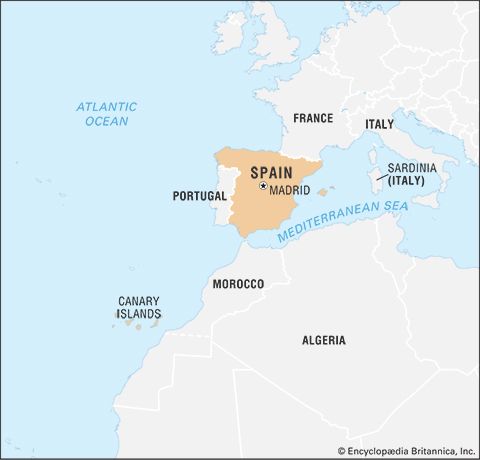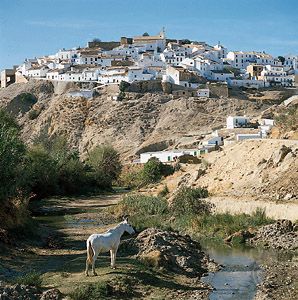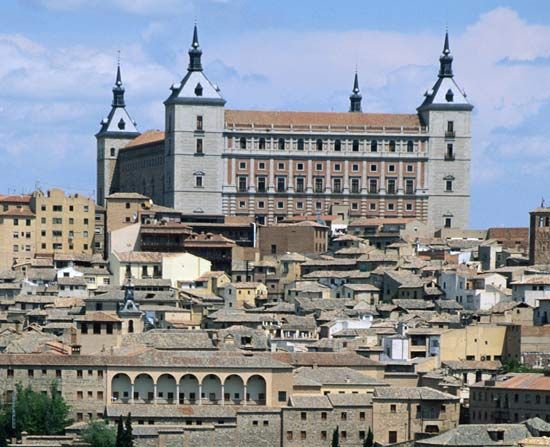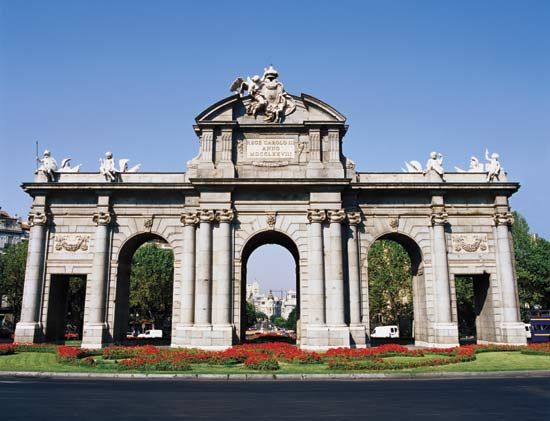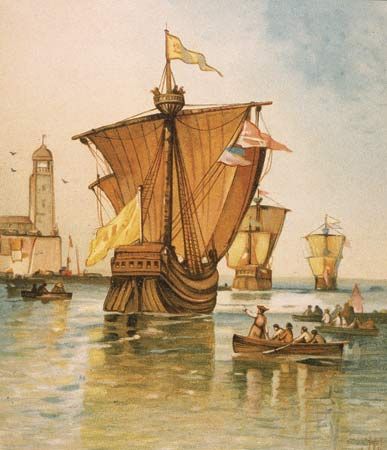Our editors will review what you’ve submitted and determine whether to revise the article.
News •
Agriculture
Because of the relative decline of agriculture since the 1960s, Spain’s rural population decreased and many farms disappeared. Spanish agriculture has remained relatively backward by western European standards: capital investment per hectare is about one-fifth the average for the Organisation for Economic Co-operation and Development (OECD), and the vast majority of farms are small. Since Spain joined the EEC in 1986, the Spanish agricultural sector has had to respect Europe-wide policies. As a result, many small-scale operations, especially in grape growing and dairying, had to cease. Since the mid-1990s, however, the amount of agriculturally productive land (especially land dedicated to organic farming) in Spain has increased through irrigation and the conversion of fallow lands.
Vegetables, fruits, and cereals are the principal crops, accounting for about three-fourths of Spain’s agricultural production (in terms of value), with cereals the principal crops. Barley and wheat, the major crops in Spain, predominate on the plains of Castile-León, Castile–La Mancha, and Andalusia, while rice is grown in coastal Valencia and southern Catalonia. Corn (maize), grown in the north, is a major fodder product. Other crops include cotton; tobacco (grown in Extremadura); sugar beets (grown mainly in the Duero and Guadalquivir valleys); olives (produced in the south), a large portion of which are used for oil; and legumes (beans, lentils, and chickpeas). Fruit growing is also significant, with citrus fruits, especially oranges (grown in the regions of Valencia and Murcia), being of greatest importance. Other fruit crops include apples, apricots, bananas, pears, peaches, and plums. Spain also produces vegetables (especially tomatoes, onions, and potatoes) and nuts (almonds).
Because Spain is one of the world’s largest producers of wine, grape growing is of considerable importance. The main wine-producing areas are La Rioja, the Penedès in Catalonia, Valdepeñas in Castile–La Mancha, the Duero valley in Valladolid, and Málaga and Jerez de la Frontera in Andalusia, which is also the centre of sherry production.
The raising of livestock accounts for just under half the value of Spain’s total agricultural output. Pigs are raised mainly in Castile-León, Aragon, and Catalonia, and pork leads meat production in Spain, followed by poultry, beef, and lamb. In the Atlantic coastal regions and the dry southern interior, sheep and dairy cows are raised.
Forestry
Forests cover more than one-third of the total land area of Spain, with much of this woodland in the Cantabrian Mountains. Forestry contributes only a tiny fraction to Spain’s agricultural production. Important forestry products are cork, eucalyptus, oak, pine, and poplar. Because centuries of erosion, harvesting of firewood, and the creation of pastureland had resulted in the disappearance of many of the country’s forests, the government initiated reforestation efforts in the 1940s that are still in progress.
Fishing
With about 5,000 miles (8,000 km) of coastline, Spain has long had an important fishing industry, which relies on fishing grounds off its coast and as far away as the Pacific and Indian oceans. The main fishing ports are in the northwest, especially Vigo and A Coruña. The activities of the commercial fishing fleet led to conflicts between Spain and a number of other countries, especially Morocco and Canada. On a number of occasions Spanish fishermen have been arrested for fishing illegally in these countries’ waters. Spain’s total catch declined during the 1980s and ’90s, but the fishing sector still accounted for about 1 percent of GDP, and fish remain an important component of the Spanish diet. Moreover, as the catch from sea fishing has declined, Spanish producers have increasingly developed coastal fish farming as an alternative.
Resources and power
Spain has one of Europe’s most important and varied mining industries. Coal—produced mainly in the Cantabrian Mountains, the eastern Iberian Cordillera, and the Sierra Morena—accounts for a significant proportion of the country’s total mineral production. Other major products include metals such as iron, copper, lead, zinc, tungsten, uranium, mercury, and gold. In order to compete with other EU countries, however, the Spanish mining industry has been forced to restructure. This need has been most urgent in Asturias, where it has led to strong protests by coal miners against government policies.
Despite the long-standing prominence of the mining industry, in general, Spain’s mineral resources are limited, and the country’s once-plentiful coal reserves are no longer sufficient for its energy needs. Moreover, Spain has virtually no petroleum of its own, and the commercial potential of its natural gas fields is limited. As a result, Spain, once a mineral-exporting country, now imports minerals on a large scale, including both coal and petroleum.
Thermal power plants, located near coal fields or ports that receive imported oil, supply about half of Spain’s electricity needs. The country also relies heavily on hydroelectric power, mainly provided by its northern rivers, which create about one-sixth of its electricity. To address its energy shortage, the Spanish government adopted an ambitious nuclear energy program in the 1960s. The first nuclear power plant began operating in 1968, and several additional plants went online in the 1980s. In 2006 the 1968 plant was closed, and the government sought to move toward renewable energy. In fact, in the early 21st century, Spain became one of the EU’s leading exponents of renewable energy, including solar and wind power. In 2007 solar thermoelectric power plants opened near Sevilla, and there are wind parks throughout the country.
Manufacturing
Spain’s early industrialization took place behind high tariff walls, and most industries remained small in scale, partly because of a lack of adequate raw materials and investment capital and partly because of weak domestic demand. Historically, industrial production has been concentrated on the northern coast and in the Basque Country, Catalonia, and the Madrid area while other parts of Spain underwent little industrial development. The liberalization of the economy in the 1960s and the influx of foreign investment, however, added a number of large firms. It also helped Spanish industry to diversify. The most striking example of this change was the automobile industry. Before 1960 Spain built few motor vehicles, but by the end of the 1980s it was producing 1.5 million vehicles in factories owned by Ford, Renault, General Motors, and the Spanish firm SEAT (largely owned by Volkswagen). During the 1990s, further liberalization of Spanish industry took place as the government privatized state-owned industrial enterprises, and telecommunications deregulation spurred an expansion of infrastructure. Meanwhile, Spanish firms, encouraged by government policy, began to address their traditional reliance on imported technologies by increasing their budgets for research and development.
Iron, steel, and shipbuilding have long been the dominant heavy industries in Asturias and the Basque Country, but in the 1970s and ’80s they began to decline because of outdated technology and rising energy costs. Much of this heavy industry was replaced by firms specializing in science and technology, a reflection of the government’s large-scale investment in the development of biotechnology, renewable energy sources, electronics, and telecommunications. The production of cotton and woolen textiles, paper, clothing, and footwear remains significant in Catalonia and neighbouring Valencia. Other leading industries include the manufacture of chemicals, toys, and electrical appliances (televisions, refrigerators, and washing machines). Consumer-oriented industries, such as food processing, construction, and furniture making, are located either close to their consumer markets in the larger cities or in rural areas where agricultural products and timber are close at hand. At the beginning of the 21st century, Madrid, Catalonia, and the Basque Country continued to dominate metallurgy, capital goods, and chemical production, but industrial production in a variety of sectors had expanded to new regions, such as Navarra, La Rioja, Aragon, and Valencia.
Finance
During the Franco regime, Spanish banks played a primary role in industrial growth and came to control much of the country’s industry. The banking sector was so highly regulated that even the number of branches a bank could maintain was controlled. It was only at the very end of the regime, in 1974, that banking experienced the same kind of liberalization that had been applied to the economy as a whole in the 1960s. In 1978 foreign banks were permitted to operate in Spain, and by the 1990s dozens of foreign banks had established branches. By the late 1990s, however, the foreign share of the banking market had declined as some foreign banks left the country and others were acquired by Spanish banks. Capital flight became a major concern in the 21st century as both domestic and international account holders, fearing for the solvency of Spanish banks in the wake of the euro-zone crisis, shifted their funds abroad.
The central bank is the Banco de España (Bank of Spain). Having complied with the criteria for convergence, Spain joined the economic and monetary union of the EU in 1998, and the Banco de España became part of the European System of Central Banks. In addition to being the government’s bank, the Banco de España supervises the country’s private banks. It is responsible to the Ministry of the Economy. In 1999 Spain adopted the euro as its official monetary unit, and in 2002 the euro replaced the peseta as the national currency.
Although Spain has a large number of private banks, the banking industry has long been dominated by a handful of large institutions. During the 1990s, in preparation for incorporation into the European monetary union, the government encouraged bank mergers to create more competitive financial institutions, a trend that continued with renewed intensity in the 21st century. This process produced three large banking groups: the Banco de Santander Central Hispano, the Banco Bilbao Vizcaya Argentaria, and CaixaBank. Even the strongest Spanish banks, however, are of only moderate size by global standards, and at the beginning of the 21st century only the Banco de Santander Central Hispano ranked among the world’s leading financial institutions. Nonetheless, Spain’s banks grew dramatically in the first decade of the 21st century, although much of that growth was fueled by a housing and construction bubble that burst in 2009. The collapse in real-estate prices, combined with a freeze in global credit markets, left Spain’s banks exposed and overleveraged. Government intervention in the banking sector reached its peak in May 2012 with the nationalization of Bankia, Spain’s fourth largest bank and its largest mortgage lender.
Spain has traditionally had a second distinct set of banks known as cajas de ahorros (savings banks), which account for about half of the country’s total savings deposits and about one-fourth of all bank credit. These not-for-profit institutions originally were provincially or regionally based and were required to invest a certain amount in their home provinces, but now they are open to all parts of the country. Surpluses were put into reserves or used for local welfare, environmental activities, and cultural and educational projects. The largest of the savings banks is the Barcelona-based La Caja de Ahorros y de Pensiones (the Bank for Pensions and Savings), popularly known as “La Caixa.” La Caixa is the largest shareholder in the CaixaBank financial group, proof that the boundary between savings banks and commercial banks had become somewhat blurry in the 21st century. This distinction was almost completely erased in the wake of the 2009 financial crisis as reforms within the savings banking sector led to widespread consolidation and commercialization. Indeed, the Bankia group was created in 2010 by the merger of seven regional savings banks, and further restructuring within the sector was seen as a necessary step to strengthening it against future shocks.
Spain has stock exchanges in Madrid, Bilbao, Barcelona, and Valencia. Yet even the largest, the Madrid exchange, is quite small by international standards. The stock exchanges were deregulated in 1989, and during the 1990s their importance increased.
Trade
Spain’s foreign trade grew rapidly during the late 20th century. The long-established pattern of imports outweighing exports continued, though earnings from tourism and other services balanced the country’s trade deficit in tangible goods. The largest share of Spain’s foreign trade is conducted within the EU; its two largest trading partners are France and Germany, and there is significant trade with Portugal, the United Kingdom, and Italy. Outside Europe the largest and most important trading partners are the United States and China. Spain also engages in significant trade with Japan.
During the mid-20th century, Spain was mainly an exporter of agricultural products and minerals and an importer of industrial goods. By the early 21st century, this pattern had changed, reflecting the increasing sophistication of the country’s economy. The main imported goods continued to be largely industrial in nature, including machinery and electrical equipment, motor vehicles, chemical and petroleum products, base metals, seafood, and paper products. But the principal exports included not only agricultural products but also motor vehicles, machinery and electrical equipment, processed iron products, chemical products, and clothing and footwear.
Services
Compared with many western European countries, Spain’s service sector is less developed, but it is still a major sector of the Spanish economy. Tourism is among Spain’s leading industries, and the country is one of the world’s top tourist destinations. Spain receives more than 55 million visitors annually—more than 10 million more people than the country’s entire population. Most visitors are European, with British, French, and German tourists making up the majority. At the beginning of the 21st century, the tourism sector accounted for about one-tenth of Spain’s GDP and employment. Spain’s central government is responsible for tourism policies and for promoting tourism overseas, while regional authorities promote tourism in their own provinces.



